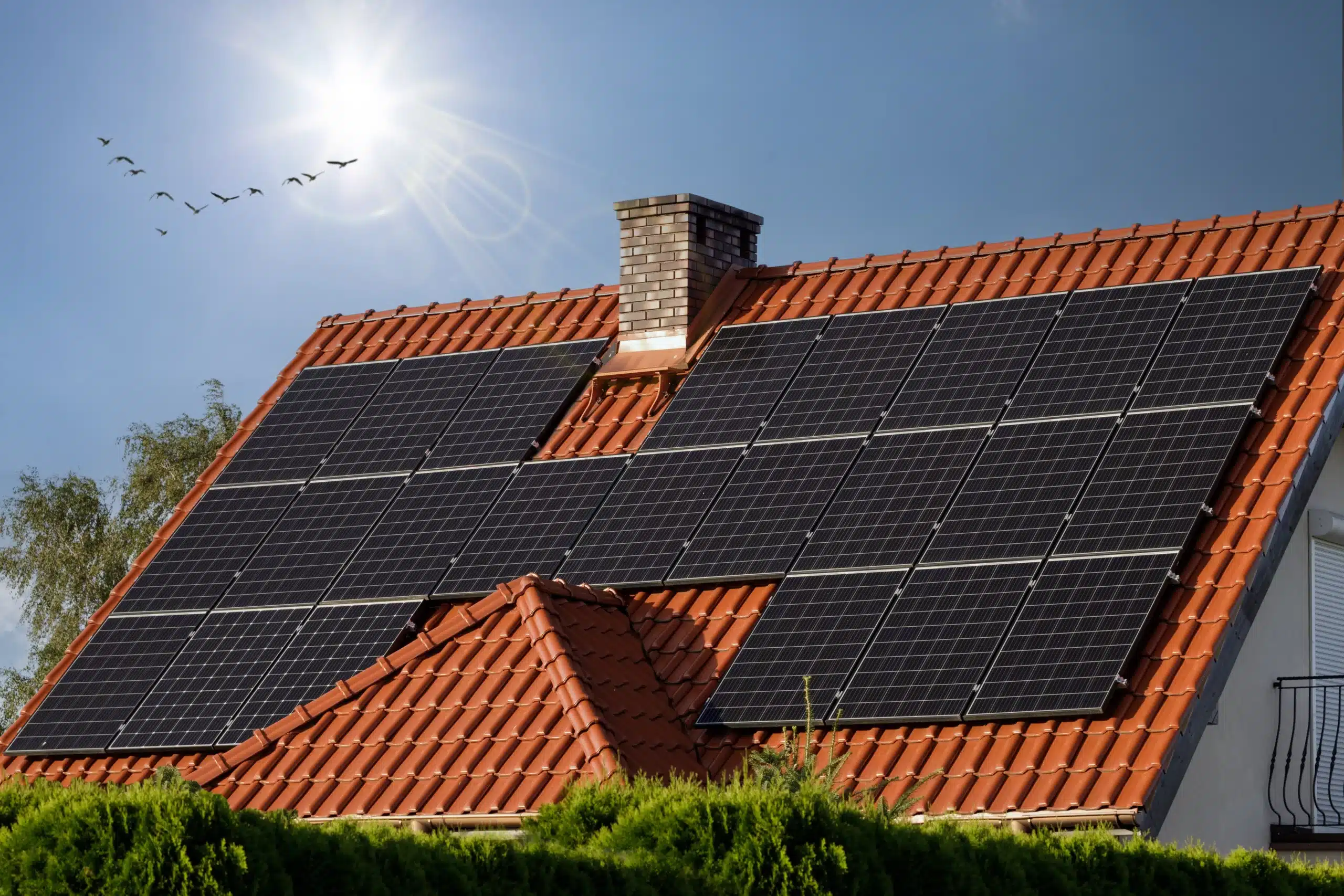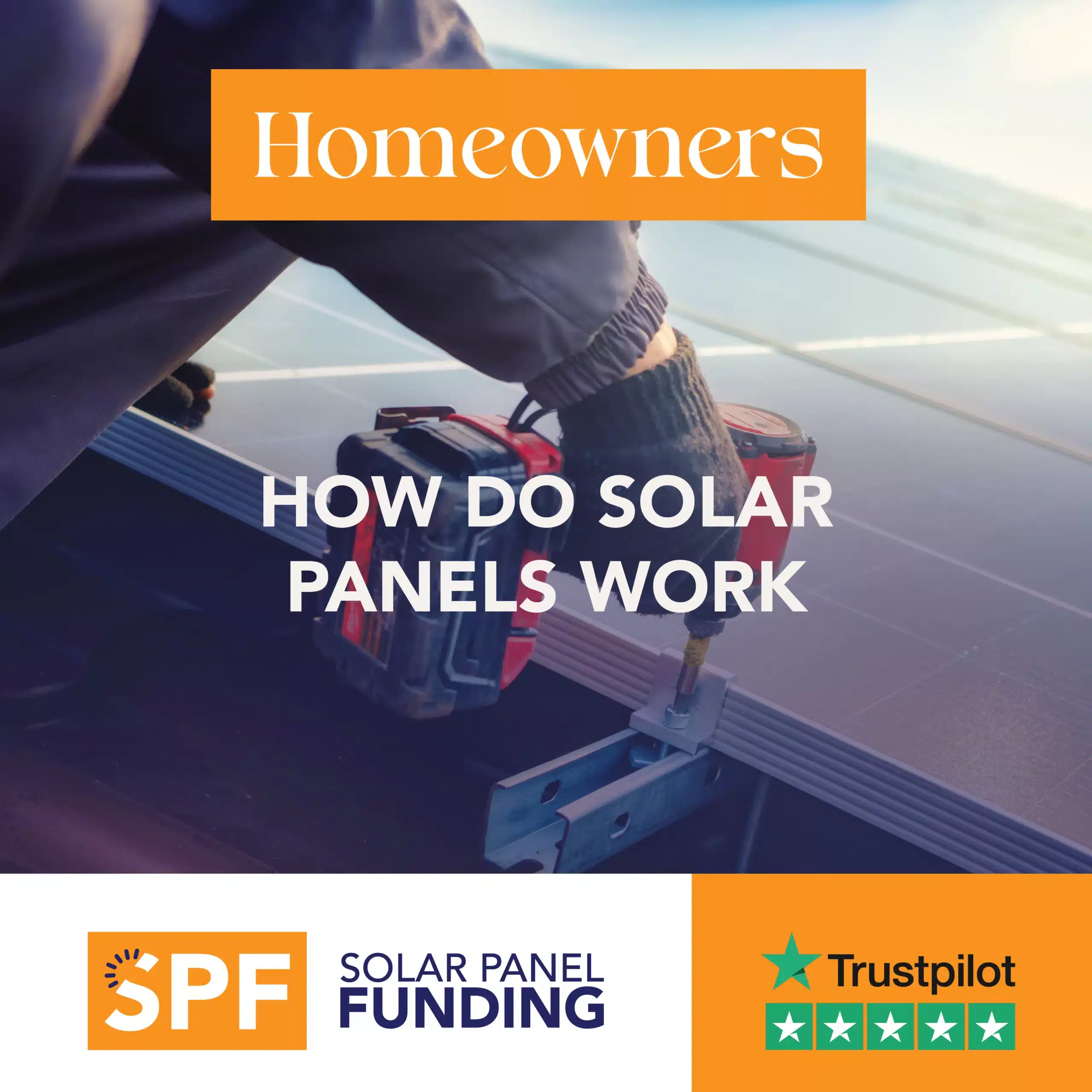
- What Is Solar Energy?
- What Are Solar Panels?
- What Are Solar Panels Made Of?
- How Do Solar Panels Work?
- How Do Solar Panels Generate Electricity?
- How Do Solar Panels Power Your Home?
- When and Where Do Solar Panels Work Best?
- Do Solar Panels Work in Winter and on Cloudy Days?
- Do Solar Panels Work During a Power Cut?
- Do Solar Panels Work at Night?
- Do Solar Panels Work in Space?
- What About Solar Farms?
- In Conclusion
Solar panels generate electricity by absorbing sunlight. But what happens next? How do solar panels work?
After absorbing sunlight, solar cells generate electricity, which then flows through an inverter to power your home. Let’s look at the science behind the photovoltaic effect.
Key Takeaways
⚡ Solar cells generate electricity because they have an electric field
🪨 Silicon-based solar cells use the photovoltaic effect to produce electricity
☀️ Photons knock electrons loose, creating an electric current
🏠 An inverter changes DC electricity into AC for home use
🔋 Extra solar power charges a battery or feeds into the grid
🌧️ Solar panels work everywhere, even in rainy UK weather
Solar panels work in any climate, from hot deserts to cloudy UK cities and even in space. They absorb sunlight, generate electricity, and reduce energy costs.
This guide explains each stage of the process, from how solar cells react to sunlight to how the electricity powers your home.
Curious about how much you could save with solar and battery storage? Answer a few quick questions below for a quote.
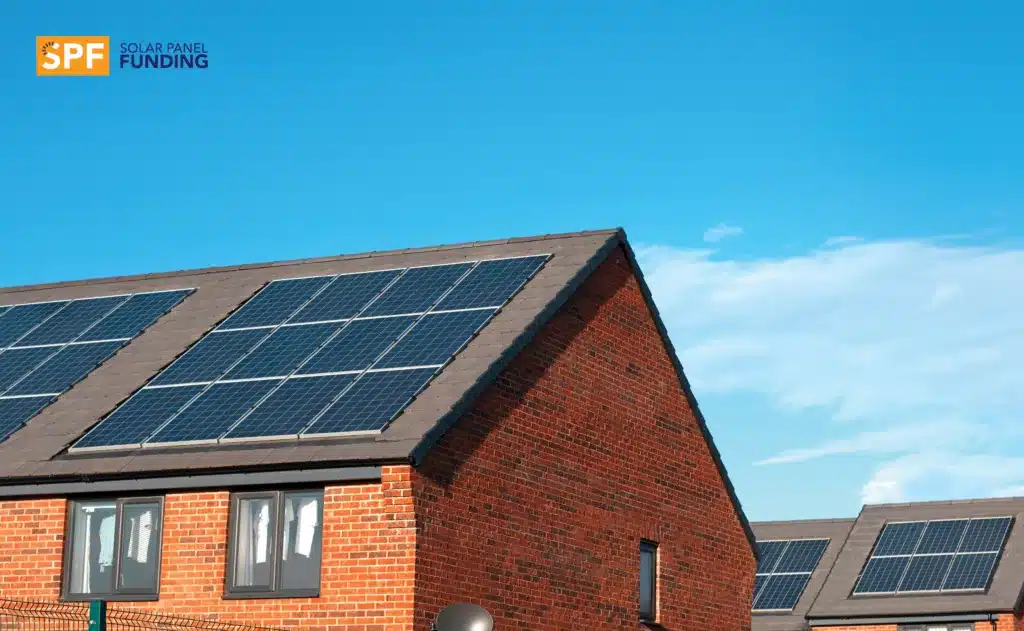
What Is Solar Energy?
Solar energy comes from light and heat produced by the Sun, but solar panels only use light energy to generate electricity.
The process begins in the Sun’s core, where nuclear fusion causes hydrogen atoms to fuse into helium, releasing photons. These photons travel to Earth, where solar panels absorb them and convert them into electricity.
What Are Solar Panels?
Solar panels generate electricity using sunlight. They are commonly installed on buildings but are also used on solar farms to produce large amounts of energy.
Each solar panel is made up of multiple solar cells, which convert sunlight into electricity. These cells are made from silicon, a material that absorbs light and generates power through the photovoltaic effect.
Around 95% of solar cells are made from silicon, a nonmetal semiconductor that efficiently converts sunlight into electricity. Each solar cell has two layers of silicon, which work together to produce an electric current.
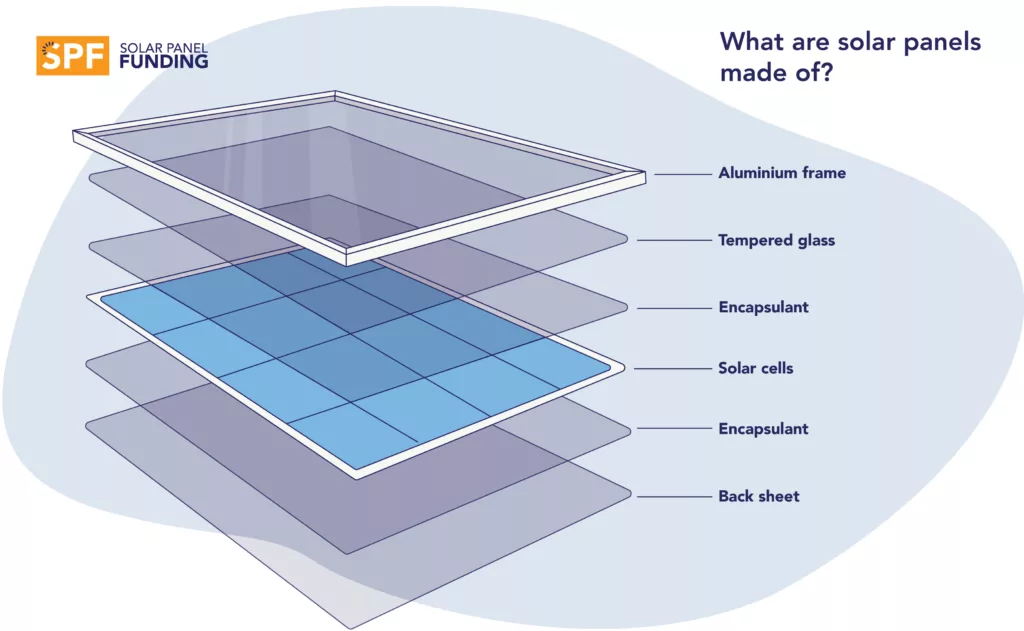
What Are Solar Panels Made Of?
Solar panels are made of several key components that work together to generate electricity efficiently.
Main components of a solar panel
Solar Cells: They are the core of the panel. Solar cells absorb sunlight and produce electricity. Most solar panels use silicon solar cells, which come in two types:
- Monocrystalline: Made from a single silicon crystal, which allows electrons to move more freely, making them more efficient and expensive.
- Polycrystalline: Made from silicon fragments, which cost less but aren’t as efficient.
Glass Casing: Keeps the solar cells safe from damage.
Insulation Layer & Back Sheet: These are found beneath the glass exterior. They prevent heat loss and protect against humidity to maintain efficiency.
Anti-Reflective Coating: Helps solar cells absorb more sunlight instead of bouncing it away.
12V Wire: Controls the amount of electricity flowing to the inverter.
Bus Wire: Links the solar cells together and moves the electricity through the panel.
Are there alternatives to silicon solar cells?
Silicon is the most common material in solar panels, but newer there are newer thinner alternatives available.
Thin-film solar cells
Thin-film solar cells are 350 times thinner than silicon cells and are made from lightweight or flexible materials. The main types include:
- Cadmium Telluride (CdTe)
- Amorphous Silicon (a-Si)
- Copper Indium Gallium Selenide (CIGS)
- Gallium Arsenide (GaAs)
Organic solar cells (OPV)
Organic solar cells (also called plastic or polymer solar cells) use carbon-based materials to generate electricity. Manufacturers print them onto thin plastics, making them flexible, lightweight and easy to use.
Perovskite solar cells
Perovskite is a newer solar technology gaining attention. These materials are highly efficient at converting sunlight into electricity.
They are made using solution processing, the same technique used to print newspapers, which makes them cost-effective and scalable.
How Do Solar Panels Work?
Solar panels sit on rooftops and solar farms, generating electricity and hot water for free using sunlight.
In the Northern Hemisphere, including Scotland, solar panels work best when facing south, allowing them to absorb sunlight throughout the day.
Since they depend on daylight, they generate electricity only when the sun is up. On cloudy days, they produce less energy, and at night, they don’t generate power at all.
Because solar panels don’t store electricity, homes still need power from the National Grid at night. Battery storage can store excess energy for later use, reducing reliance on the grid.
How Do Solar Panels Generate Electricity?
Photovoltaic (PV) cells inside solar panels absorb sunlight and generate an electric current.
This process, known as the photovoltaic effect, releases electrons and creates direct current (DC) electricity.
Since homes use alternating current (AC) electricity, an inverter converts DC into AC so it can power appliances and be sent to the grid.
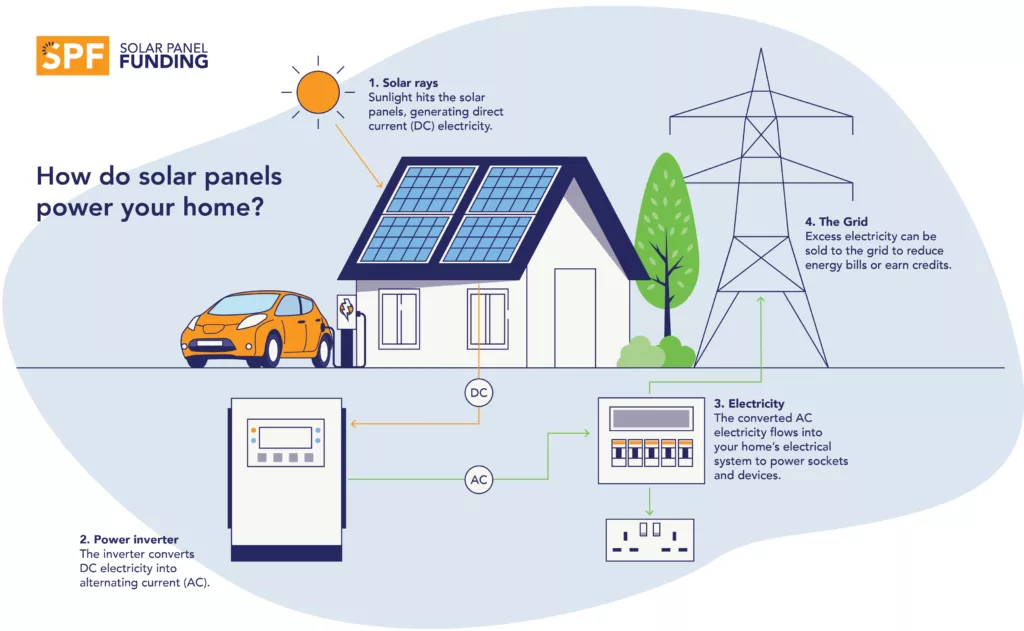
How Do Solar Panels Power Your Home?
Once the solar panels generate electricity, the system follows these steps to power your home:
1. Solar cells absorb sunlight and generate DC electricity
Light energy excites electrons in the silicon layers, creating an electric current.
2. The inverter converts DC electricity to AC electricity
Since most home appliances run on AC power, an inverter transforms the solar-generated DC electricity into a usable form.
3. Electricity flows through your home
The converted electricity is sent to your home’s electrical panel, which distributes it to your sockets and appliances.
4. Smart energy management
Since solar panels generate the most power midday, using energy-intensive appliances like washing machines during this time maximises savings. Smart plugs and timers can help optimise energy use.
5. Excess electricity is stored or exported
If your system produces more electricity than your home needs, the surplus energy can:
Charge a battery for use at night or during low sunlight.
Be exported to the National Grid, allowing you to earn money through a solar export tariff.
To learn how much you could save and earn with solar, check out our guide for UK homeowners.
When and Where Do Solar Panels Work Best?
Solar panels perform best in summer when the sun is higher in the sky, the days are longer, and the skies are clearer.
The ideal installation angle is around 35 degrees, helping them absorb the most sunlight throughout the year.
They work well in cities, suburbs, and rural areas, even in rainy countries like the UK. The UK receives 60 percent of the solar radiation found at the equator, which is like parts of France, Spain, and Germany.
Placement matters too. Solar panels should be positioned away from shade to receive the most daylight.
Do Solar Panels Work in Winter and on Cloudy Days?
Solar panels work on cloudy days and in winter, but their efficiency is lower. However, even with weaker sunlight, they still generate electricity on cloudy days using diffuse light.
In winter, solar production drops to 10 to 12 percent of annual output, while summer accounts for 40 percent. Despite this, countries like Germany and the UK successfully use solar energy year-round.
Do Solar Panels Work During a Power Cut?
Standard grid-connected solar panels do not work during a power cut. Even if your panels are generating electricity, the system shuts down automatically for safety reasons. This prevents electricity from feeding back into the grid, which could endanger repair workers fixing power lines.
However, homes with solar battery storage and an off-grid inverter can continue using stored solar power when the grid is down. A battery allows your system to function like a backup generator, keeping essential appliances running during an outage.
For full energy independence, some homeowners install off-grid solar systems that operate entirely without the National Grid. These setups require larger battery capacity to store enough power for nighttime and cloudy days.
Do Solar Panels Work at Night?
Solar panels do not generate electricity at night because they need daylight to produce power.
If you have a solar battery, the excess electricity your panels generate during the day can be stored and used later. Without a battery, you will need to use electricity from the grid after sunset.
While solar panels reduce energy bills during the day, battery storage helps you rely less on grid power overnight.
Do Solar Panels Work in Space?
Yes, and they work even better in space than on Earth. Satellites and space stations use solar panels as their main power source because there’s no atmosphere to block sunlight and no weather to reduce efficiency.
A 2024 study found that space-based solar panels could be up to 13 times more efficient than those on Earth.
Researchers are exploring the potential for orbiting solar farms that could collect energy in space and transmit it back to Earth as a zero-carbon power source.
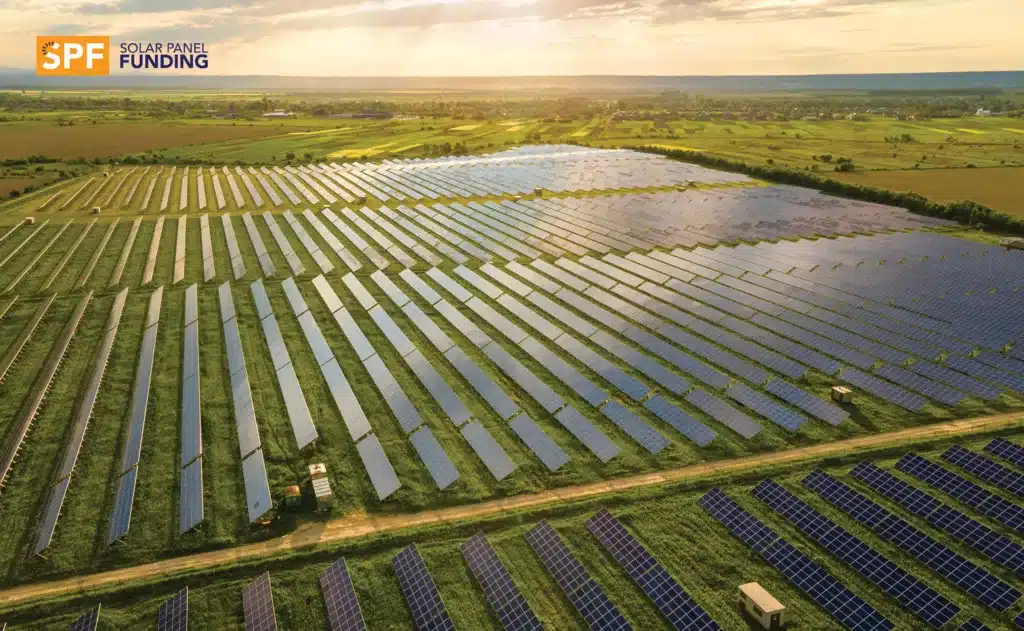
What About Solar Farms?
A solar farm is a large collection of solar panels connected together to generate electricity for homes and businesses. While an individual solar panel powers a single home, a solar farm links thousands of panels to feed power into the National Grid.
Solar farms use the same photovoltaic effect as rooftop solar panels. Each panel absorbs sunlight, knocks electrons loose, and creates electricity.
The key difference is scale. Solar farms generate enough energy to power entire towns instead of a single building.
These farms don’t always have to be on land. Some float on water, others run along railway tracks, and some are installed high on buildings and urban structures, but the way the panels generate electricity remains the same.
In Conclusion
Solar panels convert sunlight into electricity using the photovoltaic effect. When sunlight hits silicon layers inside solar cells, electrons are released, creating direct current (DC) electricity. An inverter then converts it into alternating current (AC), which powers homes and businesses.
✅ Solar panels only generate electricity during daylight.
✅ They work in all climates but produce more energy in direct sunlight.
✅ Extra electricity can be stored in a battery or sent to the grid.
Solar panels are an efficient way to generate renewable energy, reducing electricity costs and providing clean power for homes, businesses, and even large-scale solar farms.
Thinking about getting solar panels? Find out how much you could save with a solar & battery system today.
How do solar panels work?
Solar panels use photovoltaic (PV) cells to absorb sunlight and generate direct current (DC) electricity. An inverter then converts it into alternating current (AC), which powers homes and businesses.
Do solar panels work on cloudy days?
Yes, solar panels generate electricity even on cloudy days by absorbing diffuse sunlight, though efficiency is lower than in direct sunlight.
Do solar panels work in winter?
Yes, but they produce less electricity due to shorter daylight hours and weaker sunlight. However, they still function as long as there is daylight.
Do solar panels work at night?
No, solar panels do not generate electricity at night. Homes without battery storage must rely on grid power after sunset.
Do solar panels work during a power cut?
Standard grid-connected solar panels do not work in a power cut. However, homes with solar battery storage and an off-grid inverter can continue using stored solar energy.
What happens to excess solar electricity?
Extra electricity can be stored in a battery for later use or exported to the grid, where homeowners may receive payments through a solar export tariff.

